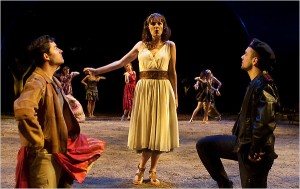The Hudson Valley Company’s rendition of The Tragedy of Troilus and Cressida seems to embrace its modern overtones as well as emphasizes its nuances on the outdoor stage. Troilus and Cressida, much like their more famous and tragic counterparts Romeo and Juliet, pine for each other, yet are unable to unite due to their wartime circumstances. Critics note how modern Troilus and Cressida seem to be, a play speaking of infidelity and dripping with satire, painting classical heroes like Hector and Achilles in a very mortal and human way. Director Terrence O’Brien staged The Tragedy of Troilus and Cressida with the intention of appealing to today’s modern audience.
Performed outdoors along the banks of the Hudson created an incredibly dramatic and organic backdrop which meshed well with the progression of the play; starting at 6 PM in the evening, the backdrop slowly went from sunny all the way to pitch black. Additionally, O’Brien appealed to the almost Hollywood aspect of the play by creating it on a grand scale. Actors were outfitted in elaborate costumes, fight scenes were choreographed epically, and the set and props portrayed the grandeur of Ancient Greece (the main setting O’Brien chose for Troilus and Cressida).
Besides the material changes O’Brien made to add some glamour to the lesser known play, some of the directorial choices actually highlight the paradoxical nature of Troilus and Cressida (is it a tragedy or a comedy? maybe it’s a history? it’s still hard to tell). In the middle of the production, the actors of Troilus and Cressida break out into an anachronistic number, singing the 1929 song “Can’t We Be Friends?” during the fourth act. As bizarre as it sounds, adding a modern day song into a centuries old classical play, one critic noted how it worked quite effectively as a palate cleanser in between the heavy battle scenes and sexual betrayal. Upon listening in closer, “Can’t We Be Friends?” actually captures the main conflict between the titular Troilus and Cressida, but in a much more digestible format for the audience. While Romeo and Juliet got to monumentalize their tragic love through their suicides, Troilus and Cressida actually live to tell the tale and experience the complications that come with love. Troilus naively believes Cressida and he have more than sex, and Cressida goes on to betray Troilus’ trust and have a promiscuous affair. By the end of the play, their love, so glistening and pure at the start, has decayed and crumbled apart. The modern song existing in the Shakespearean play serves as a paradox on the meta of Troilus and Cressida; their romance is bitter, jester is jaded, and the heroes are anything but heroic. One critic describes how the characters of Troilus and Cressida remind them of other memorable Shakespearean characters, but lacking in their one key quality: “Troilus and Cressida become a deromanticized Romeo and Juliet; Troilus, an Othello without grandeur; Thersites, a Falstaff without warmth.” Ultimately, it’s not all that out of place to have a song performed in this already categorically ambiguous play as Thersites does sing a love song. Maybe in another rendition of Troilus and Cressida, Thersites could sing an R&B love song too.

